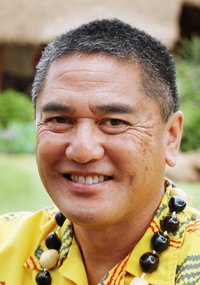Polynesian Cultural Center & Brigham Young University- Hawaiʻi
Mentor: Kaipo Mānoa
STEM Fields: Indigenous Sciences; Marine Science; Maritime Indigenous Technology; Open Seas Navigation Cartography
Internship Research Goal: Perpetuate traditional Hawaiian knowledge by learning and sharing traditional seafaring methods and practices with others.
Website: https://www.polynesia.com
Facebook: https://www.facebook.com/PolynesianCulturalCtr
Instagram: https://www.instagram.com/polynesianculturalctr
Twitter: https://twitter.com/polynesia
 About Polynesian Cultural Center
About Polynesian Cultural Center
The Polynesian Cultural Center was created to share the cultures, diversity, and spirit of the nations of Polynesia with the world. In order to accomplish their mission, the Polynesian Culture Center portrays the cultures, arts, and crafts of Polynesia. The Center consists of several villages- each representing a different culture and island nation.
In the Hawaiian village, the center staff conducts demonstrations, lectures and invites guests to participate in activities and learn more about Native Hawaiian culture and practices. For example, the staff teaches guests about the ahupuaʻa system including discussions about agriculture and aquaculture. In addition, guests learn about hula kahiko, how to make poi, and play traditional Hawaiian games such as ʻulu maika and kōnane.
Behind the Hawaiian Village is the Center’s, hale waʻa or canoe house, which houses the Iosepa, a double-hulled canoe. In this area of the Center, guests learn about sea voyaging, open seas navigation and the migration of people across the Pacific Ocean.
 Meet Our Internship Mentor: Kaipo Mānoa
Meet Our Internship Mentor: Kaipo Mānoa
Kaipo Mānoa was born and raised in Nānākuli on Oʻahu. In elementary school, Bishop Museum loaned artifacts to his elementary school so that the 4th and 5th graders could learn more about Hawaiian culture. Kaipo Mānoa remembers an influential experience he and his classmates had of learning to build a Hawaiian hale (house) using traditional methods such as preparing the ʻōhiʻā logs by scraping the bark off with ‘opihi shells they collected from the beach, and gathering coconut then twisting the fibers of the husks into rope used as lashing for the hale posts and beams. Building this hale took a year to complete, and the process sparked Kaipo’s appreciation and preference for learning through cultural ways and from cultural perspectives rather than through more Western academic ways. He learned it was easier for him to grasp new concepts and knowledge when learning with culture infused within his education and continued to use this cultural approach to learning throughout his life.
After graduating from Nānākuli High School, Kaipo Mānoa attended Brigham Young University- Hawaiʻi and began working at the adjacent and affiliated Polynesian Cultural Center. While working at the Center’s Night Show and Hawaiian Village, he continued his exploration of traditional Hawaiian practices, such as performing as a Polynesian dancer and musician, and learning how to weave lauhala and ‘ie‘ie, and how to make poi pounders and leihulu (feather lei) from cultural practitioners. Kaipo Mānoa also traveled to Kawaihae on Hawaiʻi island to learn traditional navigation or wayfinding techniques, as well as, how to be a crew member on a double-hulled canoe.
Through his experiences with these cultural mentors, Kaipo learned of the remarkable skills and talents the Native Hawaiian people had in what we consider science, technology, engineering and math (STEM) fields today. For example, the Native Hawaiians used traditional wayfinding techniques to travel 2,400 miles across the open ocean to reach Hawaiʻi and then go back across the Pacific to their home island. This was the longest distance traveled without encountering another island or land. The Native Hawaiians were also practicing scientists (like marine biologists and soil scientists) in their daily lives as they carried out tasks such as farming and fishing.
Now, as a manager at the Polynesian Culture Center, Kaipo’s job is to perpetuate traditional Hawaiian knowledge by sharing these traditional methods and practices with others. By doing so, Kaipo uses his passion for his culture and cultural knowledge to instill the love of learning and of Hawaiian culture in others and as his way to keep these cultural traditions alive.
Kaipo Mānoa also works as an adjunct faculty member in the Culture, Language and Performing Arts department at Brigham Young University- Hawaiʻi.
Internship duties and responsibilities
Students will learn the duties of a crew member of Iosepa, a 57 foot traditional double-hull sailing canoe, such as knot tying, man overboard drills, maintenance, and how to use the toilet (there are no actual toilets on Iosepa). They’ll learn oli/chant, Hiki Mai e Na Pua and proper cultural protocol involving the canoe. Special attention will be given to Malama aina/ caring for the land and identifying indigenous plants and animals and how to use them on a long voyage. Malama kai will discuss the importance of keeping and caring for our oceans and island home as a sustainable resource. They will have to memorize the basics of wayfinding including celestial navigation using the four Hawaiian Star lines and use a 9 foot, 369° Star Compass to learn the rising points of the sun and 21 of the brightest stars. They will also learn how to observe wind direction and speed, the shapes of clouds and the color of the sky near the horizon. Mathematics will be used to teach how to monitor speed on a canoe to determine course using dead reckoning and determining position East or West of reference course.
Important note: Students will not sail on the canoe in the ocean. All work will be completed on land.
Interns should be comfortable with and able to:
- Work on a team.
- Communicate with others (such as sharing cultural knowledge with guests).
- Be willing to get dirty.
Work with your hands.
2023 Internship Schedule:
- Spring 2023: Saturday, March 4 and Saturday, March 18, 10am – 2pm
- Summer 2023: June 19-30, M-F, 10am – 2pm
Internship Meeting Location:
Polynesian Cultural Center (Waialeʻe)
58-207 Kamehameha Hwy.
Haleiwa, HI 96712
